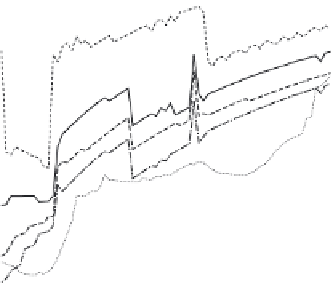Geoscience Reference
In-Depth Information
1.5
V
p
/
V
s
= 1.5
V2
V
/
V
s
V0
V1
1.0
Vcs
V3
Vcc
0.5
0
0.1
0.2
distance from bender tip: m
Fig. 6.7. Deduced shear wave velocities normalised with actual shear wave velocity
(
V
p
/
V
s
=
1
.
5) (Arroyo et al., 2006)
Both simulation and experimental observation show very clearly the difference between
the input and received waves: the output signal contains much richness which could in
principle be decoded to reveal more information about the constitutive properties of the
soil and the effectiveness of the boundaries.
4. NEMISREF mitigation of foundation response
AcasehistoryofphysicalmodellingontheearthquakeshakingtableatBristolUniversity
is provided by the NEMISREF project (New Methods of Mitigation of Seismic Risk on
Existing Foundations), an EU funded project under the GROWTH programme involving
academic and industrial partners from UK, France, Greece, Portugal and Romania.
Itaddressedthreethemes:liquefactionoffoundationsoils,siteeffects(horizontalground)
and site effects (slopes). Here we show some of the results of modelling relating to the
second theme.
Horizontal ground shaking is a major cause of damage during earthquake events. The
design of new buildings can take advantage of many technologies to mitigate the hazard,
but these mitigation techniques are quite costly, intrusive and damaging when used to
retrofit an existing structure. Site effects result in neighbouring locations experiencing
significantly different levels of shaking during earthquakes. The main motivation of the
NEMISREF project was to investigate how an engineered modification of the character-
istics of foundation soil could produce an artificial site effect which would significantly
improve the effect of earthquake motion on the structure itself.






